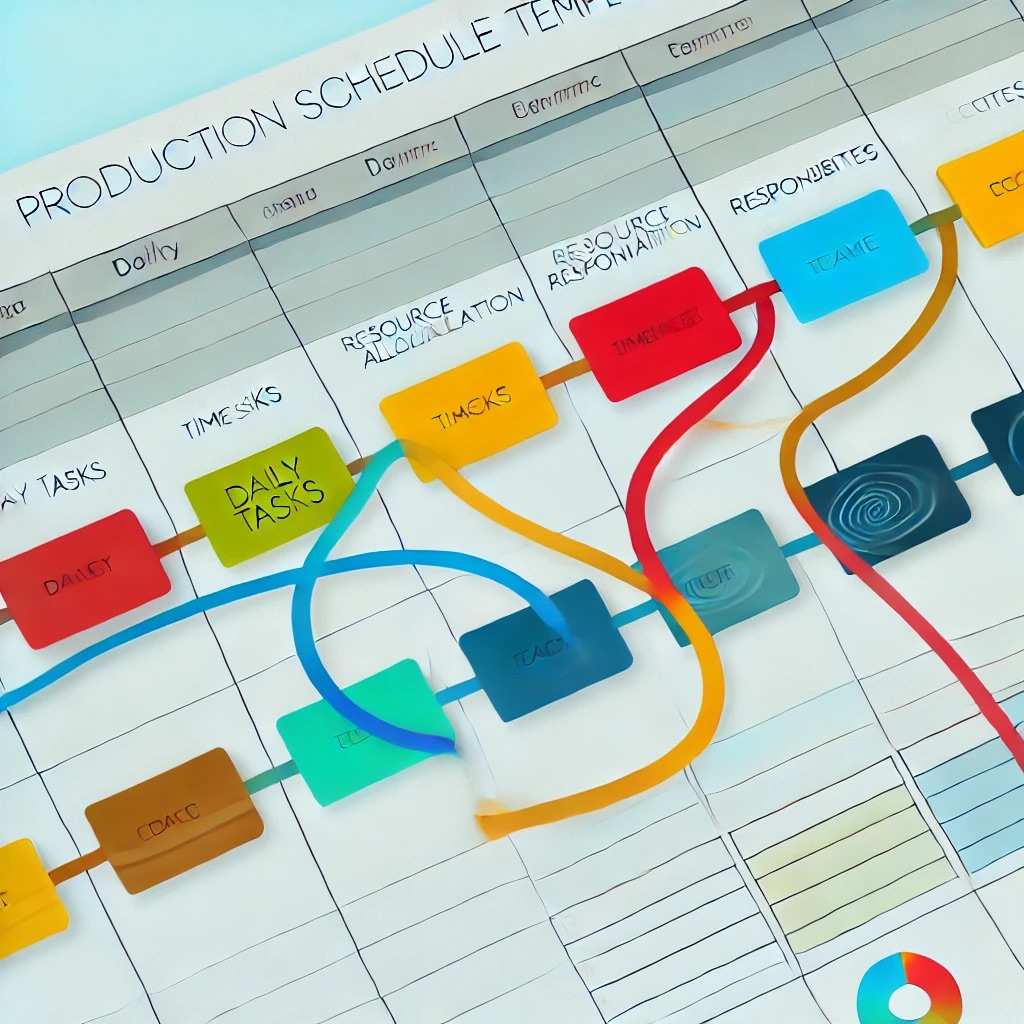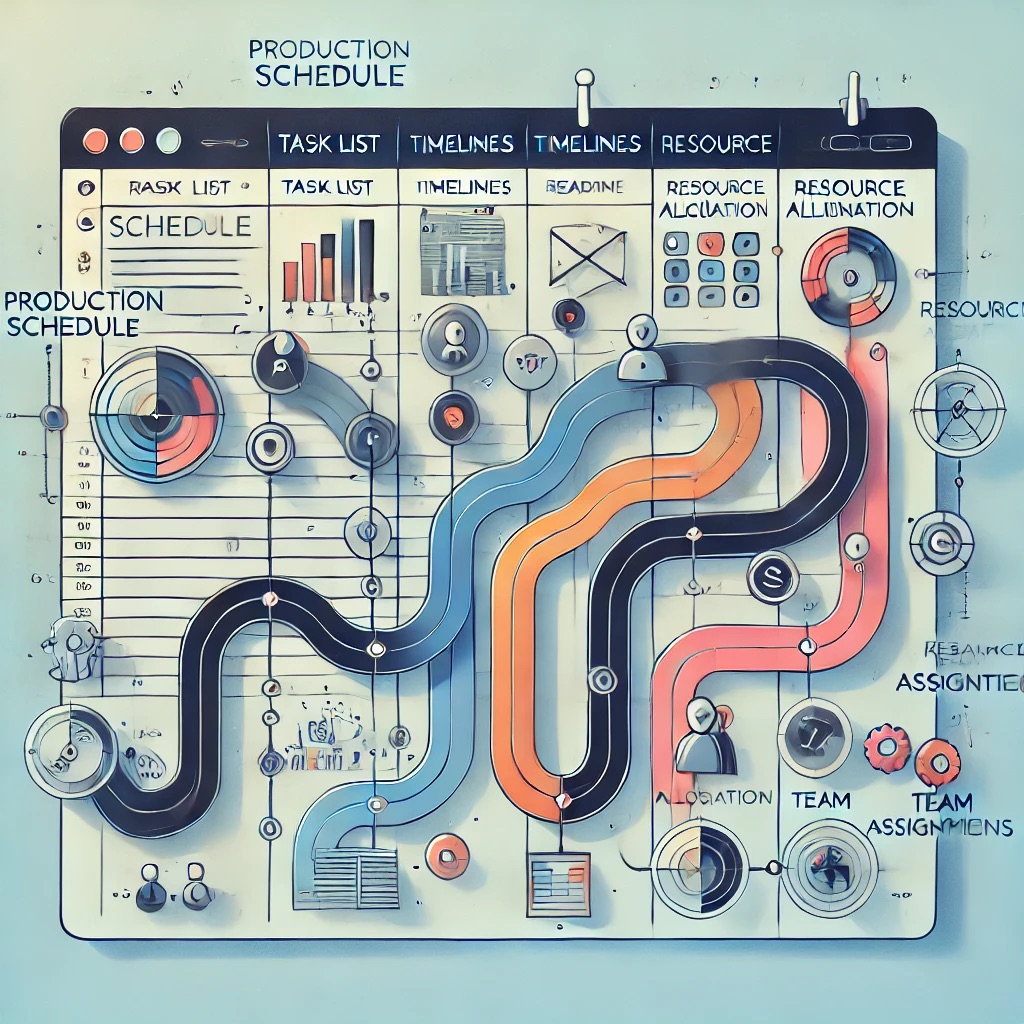Easy Guide to Building a Smooth Production Schedule
 Valcu Denis
Valcu DenisTable of contents

A production schedule is essential for businesses to manage the planning, sourcing, and production process effectively. It ensures products reach the market on time, meeting demand with efficiency. In this guide, we’ll explore how to create a production schedule, the different methods and stages involved, and the key elements of a master production schedule. Plus, we’ll share templates to help streamline your scheduling process.

What is Production Scheduling?
A production schedule is a master plan listing all products in the manufacturing process, from initial sourcing to finished goods. It covers raw materials, production processes, and logistics, acting as a communication bridge between the sales and production teams. The sales team informs production of demand levels, while the production team provides timelines for delivery, aligning both departments on what needs to be produced and when.
Production schedules are dynamic and must be updated regularly to reflect changes in demand, resources, and production needs.
Production Planning vs. Production Scheduling
Production planning is a long-term strategy focusing on balancing supply and demand. It involves creating a realistic plan that aligns with capacity and resource availability. Production planning defines key factors such as:
The quantities and types of products needed for a specific period
The timeframe for production
Necessary raw materials and workstation requirements
On the other hand, a production schedule breaks down this plan into actionable steps, offering a tactical way to implement production planning in alignment with set goals.
Why Create a Production Schedule?
A well-structured production schedule improves overall efficiency and minimizes potential delays or resource wastage. Here are some key benefits:
Efficient Resource Allocation: Proper scheduling optimizes the distribution of raw materials and resources, preventing bottlenecks.
Inventory Management: It helps maintain balanced inventory levels, avoiding overstocking and stockouts.
Labor Optimization: With scheduled working hours and defined tasks, labor is used efficiently to meet demand.
Maximized Equipment Utilization: By identifying and addressing bottlenecks, production schedules optimize equipment performance, reducing the need for additional machinery.
Reduced Lead Times: Efficient scheduling helps reduce overall lead times, meeting customer demand more quickly.
Production Scheduling Methods
Choosing the right scheduling method depends on the nature of your business. Here are the main methods:
Infinite Capacity Planning: This approach assumes unlimited resources, making it suitable for simple production setups with limited bottlenecks. It focuses on maximizing production without resource limitations.
Finite Capacity Planning: This method considers resource limitations, making it ideal for complex production processes with potential bottlenecks. Tasks are scheduled to fit within actual resource availability.
Forward Scheduling: Starting from the earliest possible date, tasks are scheduled sequentially. This approach is suitable for companies with a make-to-stock model.
Backward Scheduling: This starts from the deadline and works backward, useful for just-in-time production where inventory is minimized, and tasks are strictly deadline-driven.
Stages of the Production Scheduling Process
Implementing a production schedule involves six main steps:
Planning: Identify production goals and resources. Decide between dynamic planning, which allows for changes, and static planning, where the schedule is fixed.
Routing: Determine the most cost-effective way to move raw materials through to finished products. Routing outlines the optimal process from sourcing to production completion.
Scheduling: Define timelines for each production stage and set the final project deadline. Choose a schedule type that fits your needs—Master Production Schedule, Manufacturing Schedule, or Retail Operations Schedule.
Dispatching: Execute the schedule by coordinating resources and instructing personnel. Clear communication ensures each team understands their responsibilities.
Execution: Implement the production plan, ensuring it progresses efficiently within the established timeframe.
Maintenance: Regularly update the schedule to reflect any changes. Clear communication is key to keeping the entire team informed of any modifications.
How to Optimize Production Scheduling
Achieving an agile production schedule means creating a flexible system that can adapt to changes quickly. Here are some best practices:
Use Dynamic Scheduling: Update schedules in real time to accommodate unforeseen changes, redistributing resources as necessary.
Manage Work-in-Progress (WIP): Keep WIP items focused on immediate needs; excessive WIP can create confusion about priorities.
Prioritize on Timeliness: Focus on on-time delivery rather than scheduled due dates alone, ensuring that each step supports efficient completion.
Free Production Schedule Templates for Excel and Word
To streamline production scheduling, here are some recommended templates:
Master Production Schedule Template
This comprehensive template includes fields for order status, product quantities, inventory levels, shipping dates, and more. You can download it in Excel format from Project Manager for a complete view of your production workflow.Production Schedule Template
Designed for tracking specific details like product descriptions, customer names, delivery dates, and comments, this template is useful for manufacturing schedules that involve various production elements. Available on TemplatesFreeDownload.Weekly Production Schedule Template
Ideal for weekly monitoring, this template is commonly used on the production floor. It enables teams to track order completion and plan for upcoming production. Downloadable from TemplatesFreeDownload.Product Strategy Template
This template focuses on strategic goals, including target markets, scheduling, and sales strategies. It provides a framework for aligning production schedules with overall business objectives. Available as a Word document on Smartsheet.Product Positioning Template
Use this template to define product positioning by analyzing target markets and customer needs. It helps identify the problems your product solves and supports strategic decision-making. Available on Smartsheet in Word format.
Key Takeaways
Creating an effective production schedule is vital for improving business efficiency and meeting customer demands. It involves careful planning, consistent monitoring, and flexibility to adapt to changes. With this guide and the provided templates, you’re equipped to organize your production schedule and navigate any challenges that come your way.
Source: What is a Production Schedule, and How Can You Make One
Read also our last article: What Is a Milestone Chart and How to Easily Build One
Subscribe to my newsletter
Read articles from Valcu Denis directly inside your inbox. Subscribe to the newsletter, and don't miss out.
Written by

Valcu Denis
Valcu Denis
Love writing about tech and gaming.